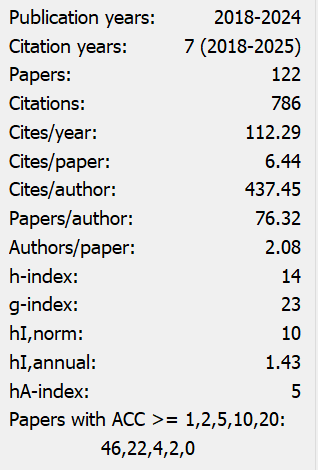Study on the Impact of the Digital Economy on Green Total Factor Productivity in Agriculture
Abstract
This study employs panel data from 30 Chinese provinces spanning 2011–2022, utilizing the SBM model and GML index to measure agricultural green total factor productivity. It empirically examines the impact mechanism of the digital economy on agricultural green TFP, while also investigating the mediating role of rural revitalization and regional heterogeneity. Findings reveal: First, the digital economy significantly enhances agricultural green TFP, with this conclusion remaining robust after a series of stability tests. Second, mechanism analysis indicates that rural revitalization plays a significant mediating role between the digital economy and agricultural green TFP. Third, heterogeneity analysis reveals pronounced regional variations in the digital economy's promotional effect. It exerts a significant positive impact on green agricultural TFP in western regions, whereas its influence on eastern regions fails to pass significance tests. This reflects that the enabling effects of the digital economy are closely tied to regional development stages and resource endowments. This study provides empirical evidence for deepening understanding of the intrinsic mechanisms through which the digital economy drives green agricultural development and offers policy implications for promoting digital rural construction and high-quality agricultural development tailored to local conditions.
References
[2] State Council of the People's Republic of China. (2022). Digital economy development plan for the 14th Five-Year Plan period.
[3] Zhu, Q., Bai, J., & Peng, C., et al. (2019). Has informatization enhanced agricultural productivity? China Rural Economy, (4), 22-40.
[4] Liu, B., Huang, C., & Pei, X. (2024). Impact of rural population aging on green total factor productivity in agriculture: Mediating effects of agricultural machinery services. Chinese Journal of Agricultural Machinery Chemistry, 1-8.
[5] Shi, C. L. (2024). Environmental regulations and China's green agricultural transformation: Enabler or obstacle? Chinese Journal of Ecological Agriculture (Chinese and English), 1-14.
[6] Yang, H., Peng, S., & Lin, P. (2024). Spatial impact and mechanism of fiscal support for agriculture on green total factor productivity in agriculture. Chinese Journal of Agricultural Resources and Regional Planning, 1-17.
[7] Li, G., Yin, Z., & Wu, Q. (2015). Rural infrastructure development and agricultural total factor productivity. Journal of Zhongnan University of Economics and Law, (1), 141-147.
[8] Ouyang, P., & Bian, R. (2025). Fiscal support for agriculture and low-carbon agricultural development: A human capital perspective. Science and Industry, 25(7), 123-127.
[9] Zhang, Y., & Luan, J. (2022). Empowering rural revitalization through the digital economy: Theoretical mechanisms, constraints, and promotion pathways. Reform, (5), 79-89.
[10] Jiao, Y., & Qi, M. (2024). Empowering new quality productive forces development through the digital economy. Journal of Economics and Management Review, 40(3), 17-30. https://doi.org/10.13962/j.cnki.37-1486/f.2024.03.002
[11] Zhang, A., & Deng, R. (2022). Impact of digital inclusive finance on green total factor productivity in agriculture and its spatial spillover effects. Wuhan Finance, (1), 65-74.
[12] Tang, J., Gong, J., & Song, Q. (2022). Digital inclusive finance and agricultural total factor productivity: A perspective based on factor mobility and technology diffusion. Chinese Rural Economy, (7), 81-102.
[13] Li, Y., Wang, C., & Pan, H., et al. (2025). Digital economy, vocational education, and common prosperity. Statistics and Decision Making, (17), 121-124. https://doi.org/10.13546/j.cnki.tjyjc.2025.17.021
[14] Du, J., Zhang, Y., & Liu, B., et al. (2023). Impact of digital villages on green total factor productivity in agriculture and its mechanism. China Population, Resources and Environment, 33(2), 165-175.
[15] Jin, S., & Ren, Z. (2022). Impact of rural digitalization on green total factor productivity in agriculture. Reform, (12), 102-118.
[16] Zhou, N., et al. (n.d.). Realization pathways of agricultural digital transformation driving rural revitalization: A knowledge map analysis based on CiteSpace. Chinese Journal of Agricultural Machinery and Chemistry, 1-10.
[17] Yang, X., & Tong, J. (2023). Spatial spillover effects of agricultural product trade on green total factor productivity in agriculture: Based on the moderating role of agricultural industrial agglomeration. Chinese Journal of Agricultural Resources and Regional Planning, 44(11), 15-27.

This work is licensed under a Creative Commons Attribution 4.0 International License.
Copyright for this article is retained by the author(s), with first publication rights granted to the journal.
This is an open-access article distributed under the terms and conditions of the Creative Commons Attribution license (http://creativecommons.org/licenses/by/4.0/).


























